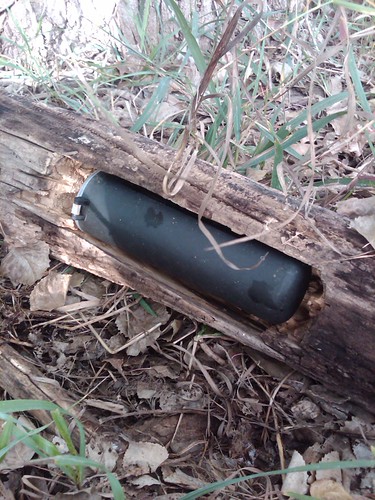They can be so much fun to play with on a rainy day. That is, until you hold one up to something that can be damaged by a good magnet.
They can also be very useful for geocaches. Today, we will be building a simple micro cache. The nice thing about this design is that it is reusable in a variety of ways, which we will look at in the future as well. Today, we will examine building the design.
Most of the supplies for this design are simple and could probably be easily found. One piece is not something you will find readily available at the nearest Wal-mart. Let's take a look:
* Superglue
* Magnets
* Logsheet
* Micro speciman container
It's the last one that is hardest to find. The ones I have actually came from a cache that was full of them for people to grab and place as a new cache. I believe it is a type of speciman container, used in science to collect and store samples. This is what it looks like:
If you look carefully at the log sheet, you can see that this container is quite small. Just barely big enough to roll up a single micro log sheet and slid it inside. Now, look at the front end of this. See the impression? Before you get a magnet, you need to make sure you know the width and depth of this impression. This way, when you acquire the magnet for this cache, you get the right size.
Getting the right magnets is important. I've mentioned it before, but we'll quickly refresh. Look for some kind of neo-dymium magnet. They are quite strong for their size and are inexpensive too. Hardware stores are your best bet, and even through them you are likely to have to order them. Grainger Industrial Supply is the store I went through, and I was able to buy 20 magnets for $10. The downside for many is that they will require you to have an account with them before selling these magnets as they are considered hazardous.
Once you have the magnets and the cache container, all you need is some superglue. Get the supplies together and let's begin.
First, decide which side you want the magnet on. The design of my container requires me to use the impression in the lid. The bottom of the container doesn't provide enough surface to attach the magnet.
Next, apply a small amount of superglue where you want to attach the magnet.
Last, attach the magnet and let it dry. It should look like this:
If you look carefully at this image, you'll notice that the magnet doesn't quite fill the width of the lid. There is a small gap. To help reinforce the magnet, I applied a tad bit more superglue into that gap. You have to be careful that you don't put too much glue. I was just barely squeezing the tube as I circled the magnet. This little bit extra glue helps secure the magnet just a bit more.
There, now you have a container that can be used in a variety of ways. Now we'll come back to this design in the future with some other ideas, but lets look at a simple way to hide that will confuse a lot of people when they first approach the cache site.
For this part of the design, you need to find a place where this is a thin, hollow tube. It is preferable if the tube is not too long. About the length of a pen is good. With regards to the thinness, it needs to be wide enough to fit the cache container, but not wide enough for someone to reach into it and grip the container. Ideally, it will be just wide enough to easily slide the container inside. This container is realitively waterproof, so if the tube is vertical, it should be okay. However, if vertical it allows water to fill up the tube and depending on how deep it is, it could float your container to the top so this should be taken into consideration. To avoid this, try to find a tube that is horizontal.
Now, here is the tricky part. You want to insert the cache container into the tube with the magnet facing out, not in. This is critical to the design. The idea is that once the geocacher figures out where the container is at, they now have to figure out how to get it out. The way to do this is to stick something metal into the tube to magnetically "grab" the cache container, and pull it back out. And not just any metal. Some metals are unresponsive to magnets. If the geocacher doesn't have the right metals with them, they won't be able to retrieve the cache.
By now, you're probably thinking "Now THAT's evil!" Yep...and a good example of how to be creative with the cache hide. I have seen this before and it had me stumped for a while. The hint helped, but until I began thinking outside the box, it had me going in a totally wrong direction. This hiding trick is something else that we might revisit in the future, but on a larger scale.
TripCyclone
















